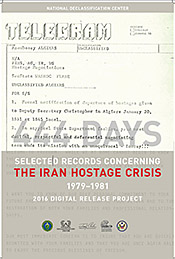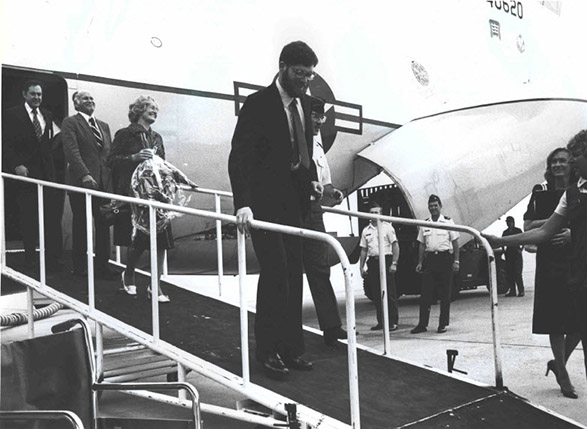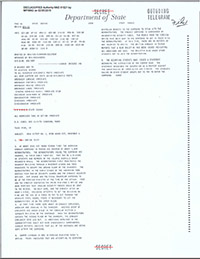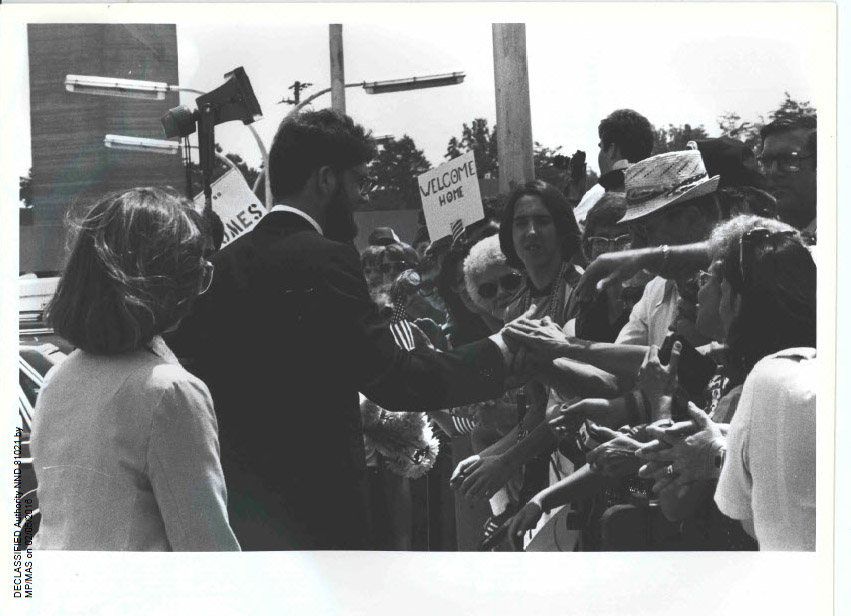
444 Days: Selected Records Concerning the Iran Hostage Crisis 1979-1981
Historical Background and Timeline
The Iran Hostage Crisis was a major international crisis caused by the seizure of the U.S. Embassy in Tehran and its employees by revolutionary Iranian students, who then held the Embassy employees as hostages, in direct violation of international law. The revolutionary government of Iran, under the Ayatollah Khomeini, supported the hostage undertaking. The crisis ended with the release of the hostages after a captivity of 444 days, from November 4, 1979 to January 20, 1981.
Since the release of the hostages, a large body of literature has been written about this event. A timeline of significant events might, however, provide a historical framework for understanding the records in this web release of newly declassified records.
- January 1978 - February 1979 – The Iranian Revolution developed gradually from modest beginnings into a nation-wide movement of protest against the government of the Shah of Iran, Mohammad Reza Pahlavi (b.1919 - d.1980).
- 16 January 1979 – The Shah of Iran went into exile, never to return to Iran.
- 1 February 1979 – The spiritual leader of the Iranian revolutionaries, Ayatollah Khomeini, returned from exile to Iran amid a tumultuous public reception.
- 11 February 1979 – The Iranian monarchy was dissolved and the Ayatollah Khomeini was granted supreme power. This day later became a new national holiday in Iran.
- 1 April 1979 – Following massive approval in a national referendum, the Islamic Republic of Iran was proclaimed.
- 22 October 1979 – The ailing Shah was admitted for medical treatment in the United States.
- 4 November 1979 – A group of 300-500 Iranian students, citing the Shah’s entry into the U.S. as a justification, seized the U.S. Embassy in Tehran and held its employees as hostages. This action received the official approval of the Khomeini government, in part to unite the Iranian people behind the new, proposed constitution, over which the Iranian people were to vote in a referendum the following month.
- 19-20 November – The Iranian students released 13 of the hostages, including all of the females and the African-Americans.
- 20 November 1979 – A force of several hundred Muslim fundamentalists seized the Grand Mosque of Mecca. The pro-American government of Saudi Arabia sent in special forces to clear the mosque, a military operation that took until December 4th to be completed, leaving hundreds of dead.
- 2-3 December 1979 – A referendum in Iran overwhelmingly approved the new, theocratic constitution for Iran, which made Khomeini the dictator of Iran.
- 28 January 1980 – Six of the U.S. employees at the Embassy, who had evaded capture by hiding in the Canadian Embassy, flew out of Tehran using fake Canadian passports.
- 24 April 1980 – A surprise U.S. military expedition to rescue the hostages was mounted, but it was aborted due to equipment failure of three of the eight helicopters. However, one of the retreating helicopters collided with a C-130 transport plane, killing eight U.S. servicemen.
- 11 July 1980 – Release of the American hostage Richard Queen, who was suffering from multiple sclerosis. This reduced the final number of U.S. hostages to 52.
- 27 July 1980 – Shah Mohammad Reza Pahlavi died of cancer in Egypt, where he had flown after being urged to leave the United States. He was buried in Cairo.
- 22 September 1980 – Saddam Hussein, the ruler of Iraq, sent his army into Iran, in part to settle long-standing border disputes with Iran, in part to seize oil-rich lands in southern Iran, and also in part because of fears of the potentially corrosive effect of Iran’s revolutionary propaganda on Iraq's Shiite Muslim majority. Hussein’s army was quickly halted by the Iranian armed forces. The war was to continue for almost eight years and ended with the deaths of perhaps one million people on both sides, while the boundaries of the two countries remained exactly as before the war.
- 4 November 1980 – U.S. President Jimmy Carter was defeated in the U.S. Presidential Election.
- 19 January 1981 – The Algiers Accords were signed, constituting the final U.S.-Iran deal to end the hostage crisis.
- 20 January 1981 – The 52 U.S. hostages were released minutes after Ronald Reagan was sworn in as the 40th U.S. president.
Project Background
The approach of the 35th anniversary of the end of the Iran Hostage Crisis in January 2016 led the National Declassification Center (NDC) to begin reviewing certain records series related to the Crisis and prepare them for release. A majority of the records came from the Department of State and documented the work done by various Department of State officials and working groups in trying to bring about a diplomatic end to the crisis. The NDC was specifically interested in records which had not been released before by the National Archives and Records Administration (NARA) and which would thus be likely to provide additional information on the Crisis. The NDC was also interested in working with other divisions of NARA that would be able to provide additional records chronicling the Hostage Crisis. Working in tandem with the NDC, staff at the Jimmy Carter Presidential Library and Museum were able to release additional records related to the Hostage Crisis that had not been previously available. These records were then included as part of this special project for a total of approximately 7200 pages of newly declassified records from several series.
Introduction to the Records
-
Records of Sheldon J. Krys Relating to Iran Hostages, 10/12/1977 – 5/14/1985. Record Group 59 (Department of State),
National Archives Identifier:
21969537
At the time of the Iran Hostage Crisis, Mr. Sheldon J. Krys served as the Executive Director of Near East Affairs (NEA), which was the unit within the Department of State that oversaw policy and operations of the State Department in that part of the world. Mr. Krys’s collection of records from this crisis form the greatest part of the newly declassified records series, which totals about 6,500 pages.
- Records Relating to Hostages in Iran, 11/4/1979 – 4/13/1981. Record Group 353 (Department of State), National Archives Identifier:
22337708
This is a small body of records, which originated with the Operations Center at the Department of State. The Center provided round-the-clock monitoring of the crisis. Although these records are generally from November-December 1979, they include a number of Situation Reports (Sitreps) that were not found in the Sheldon J. Krys series.
-
Records of the Office of the National Security Advisor (Carter Administration), 1977 – 1981, National Archives Identifier:
560131.
This collection contains the following select series of documents related specifically to the Iran Hostage Crisis. See details on select documents featured- Zbigniew Brzezinski Material - CIA President’s Daily Brief Files (NSA 2)
(National Archives Identifier: 560144) - Zbigniew Brzezinski Material - Country Files (NSA 6)
(National Archives Identifier: 560151) - Zbigniew Brzezinski Material - Office Files (NSA 15)
(National Archives Identifier: 560164) - Zbigniew Brzezinski Material - Cables Files (NSA 16)
(National Archives Identifier: 560165)
- Zbigniew Brzezinski Material - CIA President’s Daily Brief Files (NSA 2)
-
Walter Mondale Papers
This collection from the Jimmy Carter Presidential Library and Museum has the series Foreign Countries Files (National Archives Identifier: 623728) that contains select documents from January 14, 1980 – April 7, 1980, related to the Hostage Crisis. See details on select documents featured
This Web Release
The images scanned for this release are a sampling of the records, about 1000 pages from a total of 7200 pages. The scanned records indicate the kind of information available in these records, but it is hoped also that they will provide some basis for research into this significant historical episode.
Situation Reports (Sitreps)
The Situation Reports (Sitreps) were up-to-the-minute, informational reports about developments of the hostage crisis. The first one was issued on the day the hostages were taken, November 4th, 1979; the last one, Sitrep No. 561, was issued on January 19th, 1981, the day before the hostages were released. Generally, there was one Sitrep issued each day, and on some days, especially early in the crisis, several were issued per day. The Sitreps were created by an informal organization within the Department of State called the Iran Working Group (IWG).
Additional Records at the Jimmy Carter Presidential Library and Museum (Atlanta, GA)
Other archival holdings of this institution will complement more fully the records described in this web release. In addition, the Library is an excellent resource for primary source documents about the Hostage Crisis in general. The Carter Library has a web page dedicated to the topic, " The Hostage Crisis in Iran".
Other Resources
-
Ronald Reagan Presidential Library and Museum (Simi Valley, CA). The Library has series related to the Hostage Crisis. For more information, check "
Research at the Ronald Reagan Presidential Library"
-
Minnesota Historical Society (Minneapolis, MN). It has a collection of items related to the Hostage Crisis from hostage Bruce Laingen and vice-president Walter Mondale.
http://collections.mnhs.org/mondale/
and
http://www2.mnhs.org/library/findaids/00685.xml
-
Purdue University (West Lafayette, IN)
It has a collection of Congressional materials relating to the Hostage Crisis ---primarily copies of legislation.
-
Penn State University (State College, PA)
It has a collection of Congressional materials relating to the Hostage Crisis, including copies of legislation.
-
Richard B. Russell Library for Political Research and Studies (Athens, GA)
It has a collection of political cartoons from the Atlanta Journal-Constitution related to the Hostage Crisis.
-
The Digital National Security Archive. Available through
ProQuest, it has over 120 declassified government documents related to the Hostage Crisis, in addition to chronologies, glossaries, and bibliographies dealing with the subject. It has over 400 documents dealing with the Iranian Revolution itself.
The National Security Archive also maintains a large, unpublished collection of declassified materials that includes numerous files pertaining to both the Iranian revolution and hostage crisis. Although it is subscription-only, it is available for free through research rooms at National Archives facilities, local libraries (email
nsarchiv@gwu.edu for information on specific local libraries) or through visiting the Smith Bagley Reading Room at the National Security Archive in Washington D.C.
-
Foreign Relations of the United States (FRUS). This series of published records by the Department of State will eventually include two volumes on the topic of Iran, one of which will deal specifically with the Hostage Crisis. They are currently under declassification review and are planned for publication in 2017 and later.



